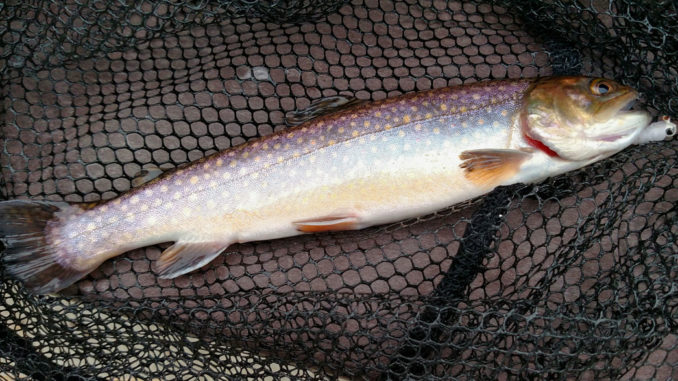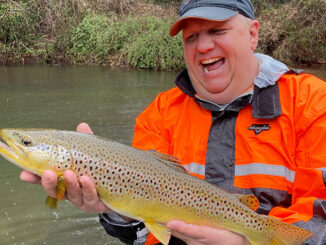
Many mountain reservoirs are trout havens
Western North Carolina and South Carolina’s Upstate have dozens of lakes with fair to excellent populations of trout. Some of these lakes, especially smaller ones, are classified as hatchery-supported waters and are regularly stocked with catchable-size fish in the spring and winter. In larger reservoirs, both stocked and wild trout enter the lakes via tributaries.
Anglers who limit their trout fishing to streams will miss some challenging fishing and some big trout. With more food resources and habitat at their disposal, trout in lakes tend to grow larger more quickly than their stream counterparts. Trout weighing 4 or 5 pounds are not uncommon.
Although trout usually are widely dispersed in lakes, the best places to find them are around the mouths of streams and rivers and in the main-lake channels where water is cooler. In the summer, they tend to congregate in deeper areas of lakes, especially around dams.
Most lake trout are rainbows, which take on a silvery sheen after a year or two in their new habitat and often are mistaken for steelhead, which were stocked in some area lakes in the 1970s.
David Yow, fishery research coordinator for the N.C. Wildlife Resources Commission, said it’s possible that the steelhead crossbred with rainbow trout.
“They’re essentially the same species,” he said.
While most are rainbows, mountain lakes also have brown and brook trout. In larger lakes, rainbows and browns can be a mix of wild and stocked trout, but the brooks most always are stockers.
The most-common and most-effective technique for catching lake trout is trolling using downriggers or lead-core line.
Randall Veal, who owns Santeetlah Marina on Santeetlah Lake in Graham County, N.C., said a sure-fire technique for catching trout is to troll the main-lake channels at about 2½ mph with a No. 44 Sutton Spoon in about 25 feet of water. After dark, the best place to fish is around dams, jigging with night crawlers under lights.
Some anglers prefer lead-core over downriggers, believing that a downrigger ball spooks fish. Lead-core is easy to use, and you get an instant hookset.
Jim Mathis of Almond Boat and RV Park on North Carolina’s Fontana Lake said he’s caught some really nice trout on his home waters, often fishing spinnerbaits around the mouth of noted trout streams such as Chambers, Hazel, Forney and Panther creeks. For deep-water trolling, he prefers spoons and Rapalas. For fishing around the dam at night, he said the anglers who have the most success “flutter” night crawlers or jigs at depths of 60 to 90 feet.
For surface fishing, small spinners such as Mepps Aglia, Rooster Tail, and Blue Fox are especially effective around feeder streams, as are small silver crankbaits.
According to biologists, North Carolina lakes with the best natural populations of trout are Fontana, Santeetlah, Glenville, Bear Creek, Cedar Cliff and Nantahala. Hiwassee Lake, Lake Chatuge and Apalachia Lake have fair populations of trout.
Stocked lakes are Cheoah, Tanasee Creek, Bear Creek and Wolf Creek, Calderwood Lake, along with smaller lakes: Queens Creek, Cliffside, Balsam, Powhatan and Max Patch Pond. These lakes are designated as mountain trout waters.
Cheoah Lake’s tailrace waters below Fontana Dam regularly produce trophy-size trout. Calderwood, managed by both Tennessee and North Carolina, also yields big trout. Tennessee stocked the reservoir with lake trout, but none have shown up in creel surveys conducted by North Carolina biologists.
Larger lakes have marinas and/or public access boat ramps. Tanasee Creek, Balsam, Queens Creek, Powhatan, and Max Patch do not have ramps. Powhatan, Balsam, and Max Patch do have fishing piers or fishing platforms.
In South Carolina, the premier trout lake is Jocassee, a 7,500-acre impoundment in Oconee and Pickens counties. A small portion of the lake lies in North Carolina.
Jocassee consistently produces trophy-size rainbow and brown trout averaging 4 to 5 pounds. South Carolina’s state records for brown trout (17.9 pounds) and rainbow trout (11.5) were caught in Jocassee.
Spring and winter fishing for trout is especially productive in the tailrace waters below Lake Hartwell on the Savannah River and Lake Murray near Columbia in the South Carolina’s Midlands. The Hartwell tailrace waters are stocked with adult trout March through June. The Lake Murray tailrace waters are stocked November through April.
Smaller lakes that offer seasonal trout fishing are Oconee County State Park Lake, Burson’s Lake, Pinnacle Lake in Table Rock State Park and Pleasant Ridge County Park Lake. Smaller lakes generally are stocked November through April.





Be the first to comment